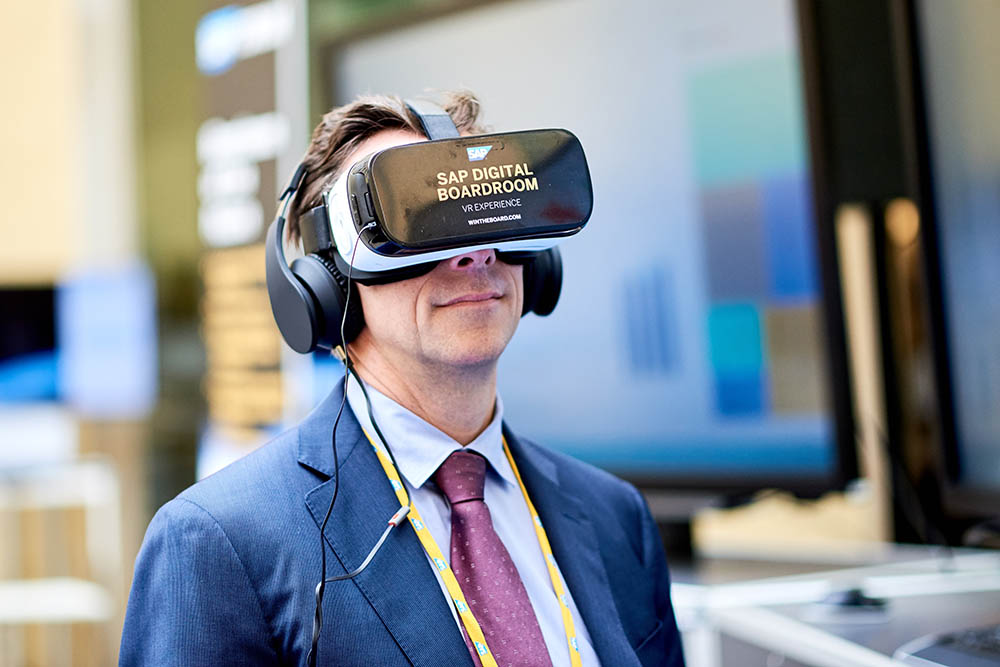Virtual and Augmented Reality have long inspired the imaginations of futurists. Take, for example, this glimpse of a potential “Domestic Robocop” HyperReality future created by designer and film-maker Keiichi Matsuda in 2010.
Every real-world surface in the short movie was covered with constantly-changing information — with lots of ads and the occasional glitch thrown in. Six years later, Matsuda has continued to create such movies, typically with a less-than-utopian view of what the future may hold.
But business soothsayers are now more optimistic about the real-world uses of these technologies. According to the analyst group Gartner, the next five to ten years will bring “transparently immersive experiences” to the workplace. They believe this will introduce “more transparency between people, businesses, and things” and help make technology “more adaptive, contextual, and fluid.”
In Gartner’s latest emerging technologies hype cycle, Virtual Reality is already on the Slope of Enlightenment, with Augmented Reality not that far behind. In other words, enterprise uses of virtual reality have started to become more widely understood, and there are real-world enterprise uses of the technology, even if it’s mostly only in pilot projects.

The Q3 issue of Digitalist Magazine, Executive Quarterly enumerates the many new business possibilities in the cover story From E-Business to V-Business.
So we know these technologies are coming to our organizations. What are some concrete steps organizations we take today to start preparing the integration of these technologies into business workflows?
Dashboards linked to the real world Augmented reality tends to rely heavily on geographical location. A good first step is to ensure than business people can view data displayed on top of maps whenever position data is available.

 These types of visualization are particular effective on mobile devices — for example, the managers of an amusement park could see the real-time data for any of their rides, as they tour the park.
These types of visualization are particular effective on mobile devices — for example, the managers of an amusement park could see the real-time data for any of their rides, as they tour the park.
 The next step is to take current location data into account when showing the visualizations — for example, allowing mobile users to show data for only locations that are closest to them.
The next step is to take current location data into account when showing the visualizations — for example, allowing mobile users to show data for only locations that are closest to them.
Then comes augmented reality, where you have the option to overlay information about a particular location onto a view through a camera.
 For example, you can provide branch managers of retail stores with latest sales figures as they walk up to a branch office:
For example, you can provide branch managers of retail stores with latest sales figures as they walk up to a branch office:
 Or let factory managers see the production records for a particular machine:
Or let factory managers see the production records for a particular machine:
 Or let a store manager compare performance of goods displayed inside the store with the goods stored in the shop window:
Or let a store manager compare performance of goods displayed inside the store with the goods stored in the shop window:
 Or let a refinery foreman see safety records of a particular pipeline:
Or let a refinery foreman see safety records of a particular pipeline:
Virtual Boardrooms. There has already been work done in the industry on virtual dashboards for business executives — for example SAP’s virtual digital boardroom application, available for iTunes or Google Play.
The application allows viewers to move around and manipulate dashboards in a virtual environment — is this a preview of the boardrooms of the future? Here are the reactions of attendees of this year’s SXSW conference in Austin, Texas:
In conclusion: it’s clear V-business is coming — are you ready?



Comments
One response to “Concrete Steps Towards Virtual And Augmented Reality In The Enterprise”
[…] from Business Analytics & Digital Business https://timoelliott.com/blog/2016/09/concrete-steps-towards-virtual-and-augmented-reality-in-the-ente… […]